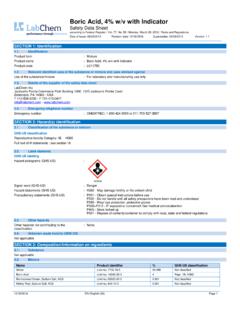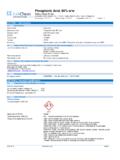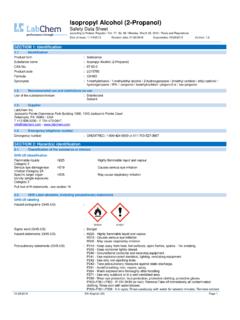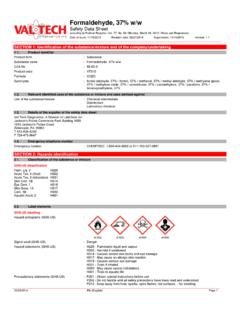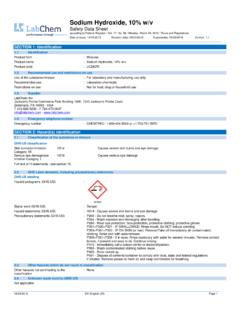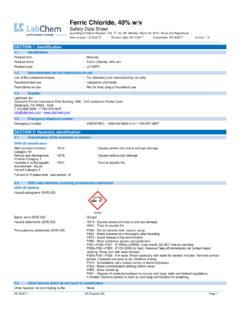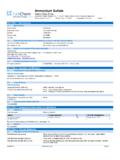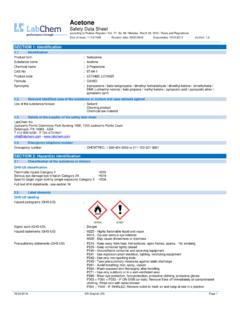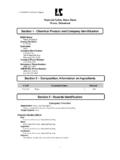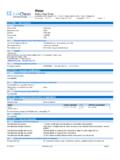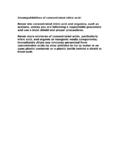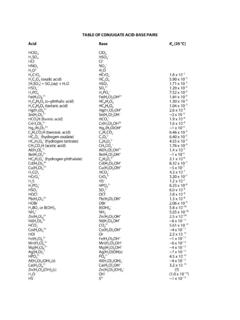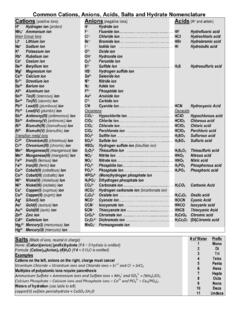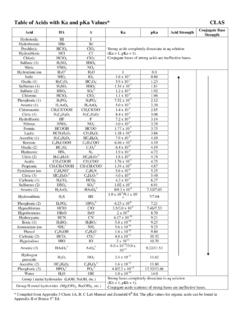Transcription of Oxalic Acid, Dihydrate(6153-56-6)
1 Oxalic acid , Dihydrate Safety Data Sheet according to Federal Register / Vol. 77, No. 58 / Monday, March 26, 2012 / Rules and Regulations Date of issue: 11/16/2004 Revision date: 01/16/2018 Supersedes: 01/16/2018 Version: 01/16/2018 EN (English US) Page 1 SECTION 1: Identification Identification Product form : Substance Substance name : Oxalic acid , Dihydrate CAS-No. : 6153-56-6 Product code : LC18040 Formula : Synonyms : dicarboxylic acid C2, dihydrate / dicarboxylic acid , dihydrate / ethandionic acid , dihydrate / ethanedioic acid , dihydrate / oxiric acid , dihydrate Recommended use and restrictions on use Use of the substance/mixture : Textile Cleansing product: component Leather/fur: dyeing Reagent Recommended use : Laboratory chemicals Restrictions on use : Not for food, drug or household use Supplier LabChem Inc Jackson's Pointe Commerce Park Building 1000, 1010 Jackson's Pointe Court Zelienople, PA 16063 - USA T 412-826-5230 - F 724-473-0647 - Emergency telephone number Emergency number : CHEMTREC: 1-800-424-9300 or 011-703-527-3887 SECTION 2.
2 Hazard(s) identification Classification of the substance or mixture GHS-US classification Skin corrosion/irritation Category 1B H314 Causes severe skin burns and eye damage Serious eye damage/eye irritation Category 1 H318 Causes serious eye damage Full text of H statements : see section 16 GHS Label elements, including precautionary statements GHS-US labeling Hazard pictograms (GHS-US) : GHS05 Signal word (GHS-US) : Danger Hazard statements (GHS-US) : H314 - Causes severe skin burns and eye damage Precautionary statements (GHS-US) : P260 - Do not breathe dust. P264 - Wash exposed skin thoroughly after handling. P280 - Wear protective gloves, protective clothing, eye protection, face protection. P301+P330+P331 - IF SWALLOWED: Rinse mouth. Do NOT induce vomiting. P303+P361+P353 - IF ON SKIN (or hair): Remove/Take off immediately all contaminated clothing.
3 Rinse skin with water/shower. P305+P351+P338 - If in eyes: Rinse cautiously with water for several minutes. Remove contact lenses, if present and easy to do. Continue rinsing P310 - Immediately call a poison center or doctor/physician. P363 - Wash contaminated clothing before reuse. P405 - Store locked up. P501 - Dispose of contents/container to comply with local, state and federal regulations If inhaled: Remove person to fresh air and keep comfortable for breathing Oxalic acid , Dihydrate Safety Data Sheet according to Federal Register / Vol. 77, No. 58 / Monday, March 26, 2012 / Rules and Regulations 01/16/2018 EN (English US) 2/8 Other hazards which do not result in classification Other hazards not contributing to the classification : None. Unknown acute toxicity (GHS US) Not applicable SECTION 3: Composition/Information on ingredients Substances Substance type : Mono-constituent Name Product identifier % GHS-US classification Oxalic acid , Dihydrate (Main constituent) (CAS-No.)
4 6153-56-6 100 Skin Corr. 1B, H314 Eye Dam. 1, H318 Full text of hazard classes and H-statements : see section 16 Mixtures Not applicable SECTION 4: First-aid measures Description of first aid measures First-aid measures general : Check the vital functions. Unconscious: maintain adequate airway and respiration. Respiratory arrest: artificial respiration or oxygen. Cardiac arrest: perform resuscitation. Victim conscious with labored breathing: half-seated. Victim in shock: on his back with legs slightly raised. Vomiting: prevent asphyxia/aspiration pneumonia. Prevent cooling by covering the victim (no warming up). Keep watching the victim. Give psychological aid. Keep the victim calm, avoid physical strain. Depending on the victim's condition: doctor/hospital. First-aid measures after inhalation : Remove the victim into fresh air.
5 Respiratory problems: consult a doctor/medical service. First-aid measures after skin contact : Wash immediately with lots of water. Do not apply (chemical) neutralizing agents. Take victim to a doctor if irritation persists. First-aid measures after eye contact : Rinse immediately with plenty of water. Do not apply neutralizing agents. Take victim to an ophthalmologist if irritation persists. First-aid measures after ingestion : Rinse mouth with water. Immediately after ingestion: give lots of water to drink. Do not induce vomiting. Call Poison Information Centre ( ). Consult a doctor/medical service if you feel unwell. Ingestion of large quantities: immediately to hospital. Doctor: administration of chemical antidote. Doctor: gastric lavage is not recommended. Most important symptoms and effects (acute and delayed) Symptoms/effects after inhalation : AFTER INHALATION OF DUST: Dry/sore throat.
6 Coughing. Irritation of the respiratory tract. Irritation of the nasal mucous membranes. Nausea. Vomiting. Symptoms/effects after skin contact : Tingling/irritation of the skin. FOLLOWING SYMPTOMS MAY APPEAR LATER: May stain the skin. Discolouration of the (finger)nails. Symptoms/effects after eye contact : Irritation of the eye tissue. ON CONTINUOUS EXPOSURE/CONTACT: Corrosion of the eye tissue. Permanent eye damage. Symptoms/effects after ingestion : AFTER ABSORPTION OF LARGE QUANTITIES: Burns to the gastric/intestinal mucosa. Nausea. Blood in vomit. Blood in stool. Shock. FOLLOWING SYMPTOMS MAY APPEAR LATER: Decreased renal function. Change in urine output. Change in urine composition. Chronic symptoms : ON CONTINUOUS/REPEATED EXPOSURE/CONTACT: Decreased renal function. Irritation of the respiratory tract.
7 Irritation of the nasal mucous membranes. Coughing. Skin rash/inflammation. Immediate medical attention and special treatment, if necessary No additional information available SECTION 5: Fire-fighting measures Suitable (and unsuitable) extinguishing media Suitable extinguishing media : Preferably: water spray. Polyvalent foam. Alcohol-resistant foam. ABC powder. Carbon dioxide. Unsuitable extinguishing media : No unsuitable extinguishing media known. Specific hazards arising from the chemical Fire hazard : DIRECT FIRE HAZARD. Non-flammable. In finely divided state: increased fire hazard. INDIRECT FIRE HAZARD. Heating increases the fire hazard. Reactions involving a fire hazard: see "Reactivity Hazard". Oxalic acid , Dihydrate Safety Data Sheet according to Federal Register / Vol. 77, No. 58 / Monday, March 26, 2012 / Rules and Regulations 01/16/2018 EN (English US) 3/8 Explosion hazard : DIRECT EXPLOSION HAZARD.
8 Fine dust is explosive with air. INDIRECT EXPLOSION HAZARD. Dust cloud can be ignited by a spark. Reactions with explosion hazards: see "Reactivity Hazard". Reactivity : On heating: release of corrosive gases/vapours (formic acid ). Upon combustion: CO and CO2 are formed. Reacts violently with (strong) oxidizers: (increased) risk of fire/explosion. Reacts violently with (some) bases: release of heat. Decomposes on exposure to UV light: release of corrosive gases/vapours (formic acid ). Special protective equipment and precautions for fire-fighters Precautionary measures fire : Exposure to fire/heat: keep upwind. Exposure to fire/heat: consider evacuation. Exposure to fire/heat: have neighbourhood close doors and windows. Firefighting instructions : Cool tanks/drums with water spray/remove them into safety.
9 Dilute toxic gases with water spray. Protection during firefighting : Heat/fire exposure: compressed air/oxygen apparatus. SECTION 6: Accidental release measures Personal precautions, protective equipment and emergency procedures For non-emergency personnel Protective equipment : Gloves. Face-shield. Protective clothing. Dust cloud production: compressed air/oxygen apparatus. Dust cloud production: dust-tight suit. See "Material-Handling" to select protective clothing. Emergency procedures : Mark the danger area. Prevent dust cloud formation, by wetting. No naked flames. Wash contaminated clothes. In case of hazardous reactions: keep upwind. In case of reactivity hazard: consider evacuation. Measures in case of dust release : In case of dust production: keep upwind. Dust production: have neighbourhood close doors and windows.
10 In case of dust production: stop engines and no smoking. In case of dust production: no naked flames or sparks. Dust: spark-/explosionproof appliances/lighting equipment. For emergency responders Protective equipment : Equip cleanup crew with proper protection. Emergency procedures : Ventilate area. Stop release. Environmental precautions Prevent entry to sewers and public waters. Methods and material for containment and cleaning up For containment : Contain released substance, pump into suitable containers. Consult "Material-handling" to select material of containers. Plug the leak, cut off the supply. Knock down/dilute dust cloud with water spray. Powdered form: no compressed air for pumping over spills. Methods for cleaning up : Stop dust cloud by humidifying. Neutralize spill with quicklime or soda ash.
